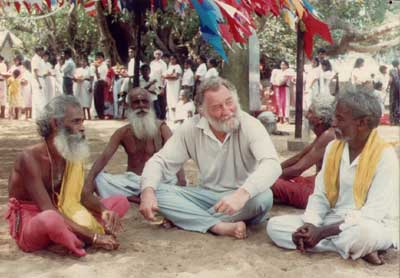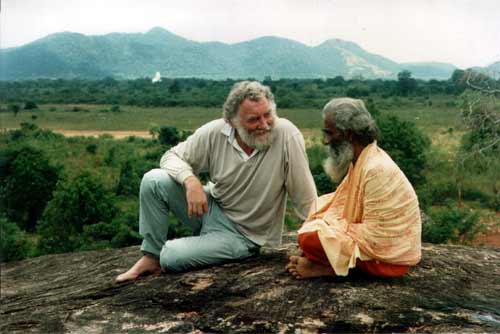|
| ||||||||
Bellamy TV series explores Kataragama
Colombo: The Sunday Island of 31 March, 1991
|

|
|
Old Kataragama hands concede that there are plenty of secrets and surprises just waiting for intrepid explorers, like Dr. David Bellamy, to uncover.
|
In his second scientific pilgrimage to Kataragama, Dr. Bellamy came armed not with pith helmet and butterfly net but with sophisticated techniques to better understand the p1ayfully elusive jungle spirit.
New analytical tools developed here in Sri Lanka have given Professor Bellamy and associates more than a fighting chance of cutting through the layers of deep secrecy that have long frustrated less sympathetic observers. And what lies beneath may very well turn out to be a vast scientific treasure of incalculable value.
Earlier in Colombo, Dr. Bellamy had addressed an assembly of concerned citizens who had gathered at the Taj Samudra to question the famed botanist about the rapidly growing list of threats to the earth's delicate biosphere. From pole to pole, he warned, the whole world now finds itself on the fast track to self-destruction unless imaginative new measures to secure global fertility are taken soon.
As a start, Bellamy formally inaugurated a bissa or traditional outdoor rice storage bin as a part of the Samudra Cottage complex of traditional village facilities. Declaring an island-wide Seed Bank project to be underway, Dr. Bellamy spelled out the special importance of seeds as banks of vital information for survival.
 |
|
Alatti Ammas: The same scheme of Rajakariya or 'Royal Service' that is believed to have been
formalized by King Dutugemunu in the Second Century B.C. still operates as faithfully handed down from generation to generation.
|
"Genetic materials, especially seeds," he explained, "are Nature's greatest gifts to humanity. They contain all kinds of information locked up in genetic code that takes millions of years for Mother Nature to develop. The industrialization of agriculture threatens to destroy much of this before anyone can discover what marvelous information is there. It's time now to do something about it."
Seeds, in other words, act as nature's memory banks, storing and releasing countless bits of vital coded information that slowly mutate and evolve over many generations. Resistance to disease and ability to respond to changes in the environment are just some of the survival functions that nature stores away until needed.
And just as rare strains of rice preserve coded survival information over generations, so likewise do archaic beliefs and ritual practices that are preserved from generation to generation in traditional village cultures.
Pursuing this approach, Dr. Bellamy was returning to Kataragama with plans to penetrate still deeper into the shrine's mystery that dates from hoary antiquity and apparently still survives. Kataragama, he learned, represents a model ancient kingdom that continues to function with or without the presence of the mythical god-king Skanda-Kumara himself.
The same scheme of Rajakariya or ‘Royal Service' that is believed to have been formalized by King Dutugemunu in the Second Century B.C. still operates there as faithfully handed down from generation to generation.
Patrick Harrigan, M.A., has collaborated with Prof. David Bellamy and other investigators into Sri Lanka's ancient science of environmental management. He now serves as acting editor of the Kataragama Research Publications Project.
| Living Heritage Trust ©2021 All Rights Reserved |
